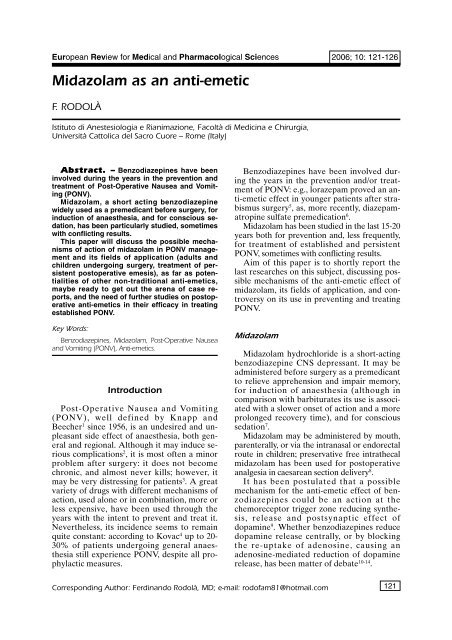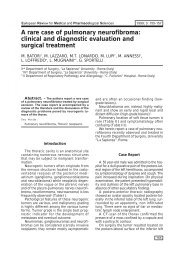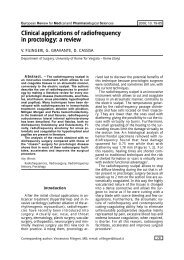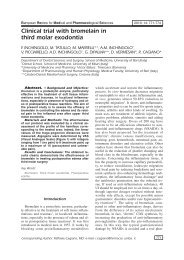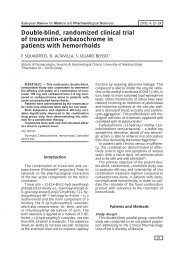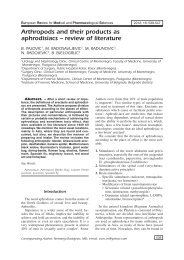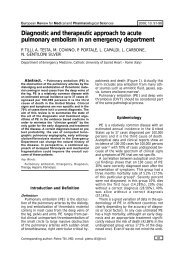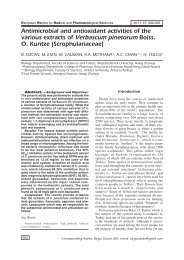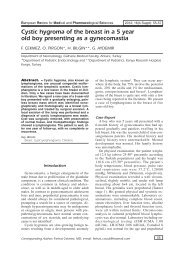Midazolam as an anti-emetic - European Review for Medical and ...
Midazolam as an anti-emetic - European Review for Medical and ...
Midazolam as an anti-emetic - European Review for Medical and ...
You also want an ePaper? Increase the reach of your titles
YUMPU automatically turns print PDFs into web optimized ePapers that Google loves.
Europe<strong>an</strong> <strong>Review</strong> <strong>for</strong> <strong>Medical</strong> <strong>an</strong>d Pharmacological Sciences 2006; 10: 121-126<br />
<strong>Midazolam</strong> <strong>as</strong> <strong>an</strong> <strong>an</strong>ti-<strong>emetic</strong><br />
F. RODOLÀ<br />
Istituto di Anestesiologia e Ri<strong>an</strong>imazione, Facoltà di Medicina e Chirurgia,<br />
Università Cattolica del Sacro Cuore – Rome (Italy)<br />
Abstract. – Benzodiazepines have been<br />
involved during the years in the prevention <strong>an</strong>d<br />
treatment of Post-Operative Nausea <strong>an</strong>d Vomiting<br />
(PONV).<br />
<strong>Midazolam</strong>, a short acting benzodiazepine<br />
widely used <strong>as</strong> a premedic<strong>an</strong>t be<strong>for</strong>e surgery, <strong>for</strong><br />
induction of <strong>an</strong>aesthesia, <strong>an</strong>d <strong>for</strong> conscious sedation,<br />
h<strong>as</strong> been particularly studied, sometimes<br />
with conflicting results.<br />
This paper will discuss the possible mech<strong>an</strong>isms<br />
of action of midazolam in PONV m<strong>an</strong>agement<br />
<strong>an</strong>d its fields of application (adults <strong>an</strong>d<br />
children undergoing surgery, treatment of persistent<br />
postoperative emesis), <strong>as</strong> far <strong>as</strong> potentialities<br />
of other non-traditional <strong>an</strong>ti-<strong>emetic</strong>s,<br />
maybe ready to get out the arena of c<strong>as</strong>e reports,<br />
<strong>an</strong>d the need of further studies on postoperative<br />
<strong>an</strong>ti-<strong>emetic</strong>s in their efficacy in treating<br />
established PONV.<br />
Key Words:<br />
Benzodiazepines, <strong>Midazolam</strong>, Post-Operative Nausea<br />
<strong>an</strong>d Vomiting (PONV), Anti-<strong>emetic</strong>s.<br />
Introduction<br />
Post-Operative Nausea <strong>an</strong>d Vomiting<br />
(PONV), well defined by Knapp <strong>an</strong>d<br />
Beecher 1 since 1956, is <strong>an</strong> undesired <strong>an</strong>d unple<strong>as</strong><strong>an</strong>t<br />
side effect of <strong>an</strong>aesthesia, both general<br />
<strong>an</strong>d regional. Although it may induce serious<br />
complications 2 , it is most often a minor<br />
problem after surgery: it does not become<br />
chronic, <strong>an</strong>d almost never kills; however, it<br />
may be very distressing <strong>for</strong> patients 3 . A great<br />
variety of drugs with different mech<strong>an</strong>isms of<br />
action, used alone or in combination, more or<br />
less expensive, have been used through the<br />
years with the intent to prevent <strong>an</strong>d treat it.<br />
Nevertheless, its incidence seems to remain<br />
quite const<strong>an</strong>t: according to Kovac 4 up to 20-<br />
30% of patients undergoing general <strong>an</strong>aesthesia<br />
still experience PONV, despite all prophylactic<br />
me<strong>as</strong>ures.<br />
Benzodiazepines have been involved during<br />
the years in the prevention <strong>an</strong>d/or treatment<br />
of PONV: e.g., lorazepam proved <strong>an</strong> <strong>an</strong>ti-<strong>emetic</strong><br />
effect in younger patients after strabismus<br />
surgery 5 , <strong>as</strong>, more recently, diazepamatropine<br />
sulfate premedication 6 .<br />
<strong>Midazolam</strong> h<strong>as</strong> been studied in the l<strong>as</strong>t 15-20<br />
years both <strong>for</strong> prevention <strong>an</strong>d, less frequently,<br />
<strong>for</strong> treatment of established <strong>an</strong>d persistent<br />
PONV, sometimes with conflicting results.<br />
Aim of this paper is to shortly report the<br />
l<strong>as</strong>t researches on this subject, discussing possible<br />
mech<strong>an</strong>isms of the <strong>an</strong>ti-<strong>emetic</strong> effect of<br />
midazolam, its fields of application, <strong>an</strong>d controversy<br />
on its use in preventing <strong>an</strong>d treating<br />
PONV.<br />
<strong>Midazolam</strong><br />
<strong>Midazolam</strong> hydrochloride is a short-acting<br />
benzodiazepine CNS depress<strong>an</strong>t. It may be<br />
administered be<strong>for</strong>e surgery <strong>as</strong> a premedic<strong>an</strong>t<br />
to relieve apprehension <strong>an</strong>d impair memory,<br />
<strong>for</strong> induction of <strong>an</strong>aesthesia (although in<br />
comparison with barbiturates its use is <strong>as</strong>sociated<br />
with a slower onset of action <strong>an</strong>d a more<br />
prolonged recovery time), <strong>an</strong>d <strong>for</strong> conscious<br />
sedation 7 .<br />
<strong>Midazolam</strong> may be administered by mouth,<br />
parenterally, or via the intr<strong>an</strong><strong>as</strong>al or endorectal<br />
route in children; preservative free intrathecal<br />
midazolam h<strong>as</strong> been used <strong>for</strong> postoperative<br />
<strong>an</strong>algesia in caesare<strong>an</strong> section delivery 8 .<br />
It h<strong>as</strong> been postulated that a possible<br />
mech<strong>an</strong>ism <strong>for</strong> the <strong>an</strong>ti-<strong>emetic</strong> effect of benzodiazepines<br />
could be <strong>an</strong> action at the<br />
chemoreceptor trigger zone reducing synthesis,<br />
rele<strong>as</strong>e <strong>an</strong>d postsynaptic effect of<br />
dopamine 9 . Whether benzodiazepines reduce<br />
dopamine rele<strong>as</strong>e centrally, or by blocking<br />
the re-uptake of adenosine, causing <strong>an</strong><br />
adenosine-mediated reduction of dopamine<br />
rele<strong>as</strong>e, h<strong>as</strong> been matter of debate 10-14 .<br />
Corresponding Author: Ferdin<strong>an</strong>do Rodolà, MD; e-mail: rodofam81@hotmail.com<br />
121
Dopaminergic neuronal activity <strong>an</strong>d 5-hydroxytryptamine<br />
rele<strong>as</strong>e may also be reduced<br />
by binding of midazolam to the GABA benzodiazepine<br />
complex 9,12,15 : thus, <strong>an</strong>xiolysis <strong>as</strong> a<br />
secondary effect may also contribute to <strong>an</strong>tiemesis.<br />
However, W<strong>an</strong>g <strong>an</strong>d Klein 16 , in a<br />
cross-sectional study exploring a possible <strong>as</strong>sociation<br />
between preoperative <strong>an</strong>xiety <strong>an</strong>d<br />
PONV in a group of children undergoing outpatient<br />
surgery did not find <strong>an</strong>y predictive<br />
value of children’s <strong>an</strong>xiety <strong>for</strong> the occurrence<br />
of PONV.<br />
<strong>Midazolam</strong> in preventing <strong>an</strong>d<br />
treating PONV<br />
<strong>Midazolam</strong> h<strong>as</strong> been used <strong>as</strong> <strong>an</strong> <strong>an</strong>ti-<strong>emetic</strong><br />
in adults <strong>an</strong>d children, both <strong>as</strong> a preventive<br />
medicine <strong>an</strong>d a rescue medication. Up to the<br />
turn of century almost only c<strong>as</strong>e reports have<br />
been published, but in the l<strong>as</strong>t few years the<br />
first r<strong>an</strong>domised controlled studies started to<br />
appear, although dosage, route <strong>an</strong>d modality<br />
of administration are still far to be st<strong>an</strong>dardized,<br />
<strong>an</strong>d almost every group of Authors used<br />
midazolam in a different way.<br />
Adult Surgical Population<br />
Studies reporting postoperative <strong>emetic</strong><br />
symptoms in adults have been per<strong>for</strong>med in<br />
various surgical settings. <strong>Midazolam</strong> h<strong>as</strong> been<br />
used <strong>for</strong> monitored sedation in adult patients<br />
scheduled <strong>for</strong> central venous access 17 , <strong>for</strong><br />
bre<strong>as</strong>t biopsy 18 , <strong>for</strong> pl<strong>as</strong>tic surgery under<br />
high-volume tumescent local <strong>an</strong>aesthesia 19 or<br />
other kind of local <strong>an</strong>aesthesia 20 . All but one<br />
of these studies 20 were not specifically designed<br />
to investigate PONV occurrence, <strong>an</strong>d<br />
reported it at a variable rate, where<strong>as</strong> more<br />
specific comparative, prospective <strong>an</strong>d controlled<br />
investigations on <strong>an</strong>ti-<strong>emetic</strong> effect of<br />
midazolam have been recently carried out in<br />
patients undergoing general <strong>an</strong>aesthesia.<br />
<strong>Midazolam</strong> h<strong>as</strong> been used <strong>for</strong> premedication<br />
in patients undergoing orthopaedic 21 ,<br />
outpatient 22 <strong>an</strong>d abdominal surgery 23 , <strong>an</strong>d <strong>as</strong><br />
a preventive drug instituted <strong>as</strong> a continuous<br />
infusion after tracheal extubation in patients<br />
undergoing cardiac surgery involving cardiopulmonary<br />
byp<strong>as</strong>s 24 . Its effectiveness <strong>for</strong><br />
the treatment of established PONV h<strong>as</strong> been<br />
studied in gynaecological <strong>an</strong>d abdominal<br />
surgery 25 .<br />
122<br />
F. Rodolà<br />
All but one of these studies 21 showed at<br />
le<strong>as</strong>t the same beneficial effect of midazolam<br />
on PONV if compared with other premedic<strong>an</strong>ts,<br />
traditional <strong>an</strong>ti-<strong>emetic</strong> medications, or<br />
placebo; the institution of a continuous infusion<br />
of midazolam after cardiac surgery 24 h<strong>as</strong><br />
been found to be more effective th<strong>an</strong> the administration<br />
of ond<strong>an</strong>setron by I.V. boluses.<br />
Paediatric Surgery<br />
<strong>Midazolam</strong> h<strong>as</strong> been studied <strong>as</strong> <strong>an</strong> <strong>an</strong>ti<strong>emetic</strong><br />
mostly in small patients undergoing<br />
strabismus surgery 26 or ear-nose-throat<br />
(ENT) operations: actually, it is reported that<br />
up to 80% of children not receiving <strong>an</strong> <strong>an</strong>ti<strong>emetic</strong><br />
<strong>an</strong>d undergoing adenotonsillectomy<br />
may suffer PONV 27,28 . Avoiding intra- <strong>an</strong>d<br />
peri-operative <strong>emetic</strong> agents <strong>as</strong> nitrous oxide<br />
<strong>an</strong>d morphine b<strong>as</strong>ed opioids 29 , using nonsteroidal<br />
<strong>an</strong>ti-inflammatory drugs (NSAIDs)<br />
or codeine <strong>as</strong> premedic<strong>an</strong>ts 30 , <strong>an</strong>d administering<br />
systematically <strong>an</strong>ti-<strong>emetic</strong>s 31 may reduce<br />
PONV rate down to less th<strong>an</strong> 20%.<br />
Safety <strong>an</strong>d effectiveness of midazolam <strong>as</strong><br />
oral premedication, after <strong>as</strong>sessment of sedation,<br />
quality of induction <strong>an</strong>d effects on g<strong>as</strong>tric<br />
contents (residual volume <strong>an</strong>d pH) have<br />
been demonstrated by Riva et al 32 ; nevertheless,<br />
papers investigating its ability in preventing<br />
PONV, even when not specifically designed,<br />
report conflicting results.<br />
Splinter et al 33 found a lower incidence of<br />
PONV th<strong>an</strong> a placebo group: 42% vs 57%,<br />
still a quite high rate, but used <strong>for</strong> <strong>an</strong>aesthesia<br />
nitrous oxide <strong>an</strong>d haloth<strong>an</strong>e, both known<br />
to be <strong>emetic</strong>.<br />
Zedie et al 34 used the same kind of <strong>an</strong>aesthesia<br />
<strong>for</strong> paediatric outpatient surgery, but reported<br />
a very low 6% of PONV. The Bergendahl<br />
group 35 did not find, in a prospective, r<strong>an</strong>domized,<br />
controlled clinical trial in children<br />
undergoing ENT surgery <strong>an</strong>y particular adv<strong>an</strong>tage<br />
in administering midazolam <strong>as</strong> a premedication.<br />
Results of <strong>an</strong>other recent study 36<br />
showed that steroids signific<strong>an</strong>tly reduce the<br />
incidence of PONV, but usual <strong>an</strong>ti-<strong>emetic</strong><br />
agents, <strong>as</strong> well <strong>as</strong> drugs known to possess<br />
<strong>an</strong>ti<strong>emetic</strong> properties such <strong>as</strong> midazolam lack<br />
<strong>an</strong>y signific<strong>an</strong>t protective effect against emesis.<br />
Persistent Emesis<br />
Persistent (not only postoperative) emesis<br />
may rise to a priority to deal with both <strong>for</strong> patients<br />
<strong>an</strong>d physici<strong>an</strong>s, <strong>an</strong>d lead to un<strong>an</strong>ticipat-
ed admissions of up to 1% ambulatory<br />
surgery patients 37 . Three c<strong>as</strong>es of persistent<br />
PONV treated with low dose midazolam given<br />
by I.V. infusion have been reported by Di<br />
Florio in 1992 9 ; the same Author 38 later compared<br />
midazolam to placebo in patients resist<strong>an</strong>t<br />
to st<strong>an</strong>dard <strong>an</strong>ti-<strong>emetic</strong> medications,<br />
achieving statistically signific<strong>an</strong>t good results,<br />
although with a limited number of patients.<br />
A c<strong>as</strong>e of a female patient presenting, according<br />
to a widely used simplified PONV<br />
risk score 39 , two or maybe more predictive<br />
characteristics, h<strong>as</strong> been quite recently reported<br />
40 . She received a subarachnoid block<br />
<strong>for</strong> orthopaedic surgery, <strong>an</strong>d developed in the<br />
recovery room a severe <strong>emetic</strong> status resist<strong>an</strong>t<br />
to all cl<strong>as</strong>s of available <strong>an</strong>ti-<strong>emetic</strong>s. Only<br />
midazolam, actually administered primarily<br />
to reduce <strong>an</strong>xiety <strong>an</strong>d prevent bad memories<br />
of the event, stopped all <strong>emetic</strong> symptoms.<br />
In this c<strong>as</strong>e the Authors suspected that<br />
a timely coincidence with a delayed onset of<br />
action of one or more of the <strong>an</strong>ti-<strong>emetic</strong>s the<br />
patient received could not be excluded.<br />
A curious c<strong>as</strong>e of severe postoperative<br />
nausea (but not vomiting), successfully treated<br />
with I.V. midazolam, h<strong>as</strong> been described in<br />
a known epileptic female patient 41 . Actually,<br />
reviewed by the <strong>an</strong>aesthesiological team, she<br />
admitted that she had a severe feeling of nausea<br />
prior to her fits; the Authors of the c<strong>as</strong>e<br />
report concluded that is worth bearing in<br />
mind that in epileptic patients, warning signs<br />
of impending seizures may m<strong>an</strong>ifest <strong>as</strong> a postoperative<br />
problem, in this c<strong>as</strong>e emesis.<br />
Interestingly, midazolam <strong>an</strong>d parenteral nutrition<br />
have proven their effectiveness in a non<br />
surgical c<strong>as</strong>e of persistent <strong>an</strong>d life threatening<br />
hyperemesis gravidarum 42 , while, more recently,<br />
a c<strong>as</strong>e of a teenage boy affected by CVS<br />
(Cyclical Vomiting Syndrome: a condition that<br />
recent literature suggests to be linked with migraine<br />
<strong>an</strong>d adrenergic autonomic dysfunction)<br />
successfully treated with a combination of I.V.<br />
midazolam <strong>an</strong>d clonidine h<strong>as</strong> been reported 43 .<br />
<strong>Midazolam</strong> h<strong>as</strong> been also found to be <strong>an</strong> effective<br />
<strong>an</strong>ti-<strong>emetic</strong> during chemotherapy 44 .<br />
Side Effects<br />
A number of drug interactions, side effects<br />
<strong>an</strong>d complications could be <strong>as</strong>sociated with<br />
the use of midazolam. According to the com-<br />
<strong>Midazolam</strong> <strong>as</strong> <strong>an</strong> <strong>an</strong>ti-<strong>emetic</strong><br />
mercial product labelling adverse effects may<br />
include hypotension, tachycardia, <strong>an</strong>terograde<br />
amnesia (actually in most perioperative<br />
situations a beneficial effect), psychomotory<br />
excitation, respiratory depression, <strong>an</strong>d even<br />
nausea <strong>an</strong>d vomiting.<br />
All but amnesia are rare on the whole <strong>an</strong>d<br />
midazolam may be considered <strong>as</strong> a quite safe<br />
drug; nevertheless, literature reports some<br />
conditions that is worth mentioning.<br />
One minor trouble of intr<strong>an</strong><strong>as</strong>al administration<br />
of midazolam in paediatric patients is<br />
irritation, <strong>an</strong>d children are likely to cry, more<br />
th<strong>an</strong> after the administration of other drugs<br />
by the same route 34 .<br />
A further problem in children may be represented<br />
by paradoxical reactions following I.V.<br />
administration of midazolam: they include restlessness,<br />
violent behaviour against relatives <strong>an</strong>d<br />
medics, <strong>an</strong>d acts of self-injury, sometimes needing<br />
<strong>for</strong> restraints. Rescue medications may be<br />
needed: recently, a controlled trial h<strong>as</strong> shown<br />
that paradoxical reactions c<strong>an</strong> be aborted by<br />
ketamine, with a not yet clear mech<strong>an</strong>ism 45 .<br />
One more concern is the administration of<br />
midazolam <strong>as</strong> treatment of persistent PONV.<br />
<strong>Midazolam</strong> is normally given by I.V. infusion<br />
at subhypnotic doses (a 0.5-1 mg bolus <strong>as</strong><br />
starter, followed by a 1 mg per hour infusion).<br />
Low dose midazolam is safe to use perioperatively,<br />
<strong>an</strong>d respiratory depression usually<br />
does not occur, even in combination with opioids<br />
46,47 ; however oxygen supplementation<br />
<strong>an</strong>d pulse oximetry monitoring are recommended<br />
48 . Elderly people are especially sensitive<br />
to such effect of midazolam.<br />
Discussion<br />
Although c<strong>as</strong>e reports <strong>an</strong>d controlled trials<br />
are now numerous, it h<strong>as</strong> been observed that<br />
midazolam does not have still widely earned<br />
accept<strong>an</strong>ce <strong>as</strong> <strong>an</strong> <strong>an</strong>ti-<strong>emetic</strong> medication 49 ; it<br />
looks to be popular in the Austral<strong>as</strong>i<strong>an</strong><br />
area 9,13,38,48,50 , where postoperative services<br />
seem to have reached a good experience with<br />
low-dose midazolam <strong>as</strong> a therapy <strong>for</strong> severe<br />
PONV recalcitr<strong>an</strong>t to <strong>an</strong>ti-<strong>emetic</strong>s 43 .<br />
Nevertheless, there is a general agreement<br />
that low dose midazolam is one of the drugs<br />
that c<strong>an</strong> <strong>for</strong>m part of the combination <strong>for</strong> difficult<br />
patients. Other non-traditional <strong>an</strong>ti-<br />
123
<strong>emetic</strong>s, <strong>as</strong> propofol 51 , clonidine 52 , dexameth<strong>as</strong>one<br />
53 <strong>an</strong>d even thiopentone 54 may be<br />
successfully used to stop emesis, <strong>an</strong>d may deserve<br />
more attention, <strong>as</strong> well: the use is not<br />
included in the labelling, but, once a drug h<strong>as</strong><br />
been approved <strong>for</strong> a certain use, experience<br />
may show its usefulness <strong>for</strong> other problems.<br />
It may be worth to lay stress on that most<br />
of these drugs fulfil the need to cut down<br />
costs of PONV treatment 55 ; more, there is not<br />
a clear evidence that prophylaxis actually decre<strong>as</strong>es<br />
the likelihood of un<strong>an</strong>ticipated admissions<br />
56 . Furthermore, patients might be put at<br />
risk of suffering from unnecessary adverse<br />
drug reactions, e.g. headache related to 5-<br />
HT3 receptor <strong>an</strong>tagonists administration 4,57 , if<br />
a widespread prophylaxis policy is adopted.<br />
Postoperative emesis is a difficult multifactorial<br />
problem involving both patient’s aptitude,<br />
type of surgery <strong>an</strong>d perioperative administration<br />
of drugs, mostly given <strong>for</strong> <strong>an</strong>aesthesia<br />
<strong>an</strong>d <strong>an</strong>algesia after surgery. In patients at high<br />
risk of PONV a multimodal approach should<br />
be adopted 58 , avoiding all avoidable risk factors<br />
depending on the <strong>an</strong>aesthesia technique<br />
itself (e.g. opiates, volatile agents, <strong>an</strong>d nitrous<br />
oxide), administering intravenous <strong>an</strong>aesthetic<br />
agents with a recognized <strong>an</strong>ti-<strong>emetic</strong> action,<br />
<strong>as</strong>suring <strong>an</strong>xiolysis <strong>an</strong>d effective postoperative<br />
<strong>an</strong>algesia, <strong>an</strong>d adopting combination prophylaxis<br />
with drugs working via different receptors<br />
50,59 . Un<strong>for</strong>tunately, both in controlled trials<br />
<strong>an</strong>d c<strong>as</strong>e reports, it is not uncommon that<br />
heterogeneity in dosage, route <strong>an</strong>d timing in<br />
administration of <strong>an</strong>ti-<strong>emetic</strong>s, <strong>an</strong>d the goal of<br />
the study itself, compromise the reliability of<br />
data to allow me<strong>an</strong>ingful conclusion; furthermore,<br />
there is still debate about a possible<br />
“hard core” of patients suffering PONV whatever<br />
<strong>an</strong>aesthetic technique is adopted 60 . In the<br />
l<strong>as</strong>t few years reliable <strong>an</strong>d validated simplified<br />
PONV risk scores, operation independent, instead<br />
of endless listing of often doubtful risk<br />
factors have been elaborated 39,61,62 . The simplified<br />
risk score by Apfel <strong>an</strong>d colleagues 39 allows<br />
to <strong>as</strong>sess the probability of PONV by the<br />
small number of the most relev<strong>an</strong>t risk factors,<br />
i.e. female gender, non-smoking status,<br />
history of motion sickness <strong>an</strong>d/or PONV, administration<br />
of opioids <strong>for</strong> postoperative <strong>an</strong>algesia.<br />
According to the Authors, if none or all<br />
four risk factors are present, PONV risk may<br />
incre<strong>as</strong>e from 10% (no risk factors) to 80%<br />
(all four risk factors). Predictive characteris-<br />
124<br />
F. Rodolà<br />
tics of simplified scores appear, according to<br />
Apfel <strong>an</strong>d colleagues 63 <strong>an</strong>d Pierre <strong>an</strong>d colleagues<br />
64 to be <strong>as</strong> good <strong>as</strong> more complex models,<br />
<strong>an</strong>d e<strong>as</strong>ier to h<strong>an</strong>dle.<br />
One more concern may be represented by<br />
the discrep<strong>an</strong>cy between the great number of<br />
trials on prevention of PONV <strong>an</strong>d a much<br />
lesser number of papers on its treatment. According<br />
to some Authors 65 the whole thing is<br />
not so surprising: therapeutic trials are logistically<br />
more difficult to per<strong>for</strong>m, <strong>an</strong>d m<strong>an</strong>ufacturers<br />
may have not <strong>an</strong>y commercial interest<br />
in the treatment of established emesis,<br />
since a preventive strategy may be worthwhile,<br />
<strong>as</strong>suming that all patients will receive<br />
the <strong>an</strong>ti-<strong>emetic</strong> drug, <strong>an</strong>d not only who needs<br />
it: that is, treatment of established symptoms<br />
is likely to be in m<strong>an</strong>y c<strong>as</strong>es more cost-effective<br />
th<strong>an</strong> prevention 66 . More, m<strong>an</strong>ufacturers<br />
seem sometimes not to be keen to compare<br />
their drugs with new <strong>an</strong>d old comparators,<br />
<strong>an</strong>d data on nausea occurrence are often disregarded<br />
or underreported.<br />
Valid data on the actual efficacy of <strong>an</strong>ti<strong>emetic</strong>s,<br />
cl<strong>as</strong>sic, new, <strong>an</strong>d even non-traditional<br />
<strong>as</strong> midazolam <strong>an</strong>d others, are still needed,<br />
<strong>as</strong> far <strong>as</strong> their ability <strong>for</strong> established PONV<br />
treatment is not completely investigated <strong>an</strong>d<br />
understood.<br />
References<br />
1) KNAPP MR, BEECHER HK. Post<strong>an</strong>esthetic nausea,<br />
vomiting <strong>an</strong>d retching. JAMA 1956; 160: 376-385.<br />
2) BREMNER WGM, KUMAR CM. Delayed surgical emphysema,<br />
pneumomedi<strong>as</strong>tinum <strong>an</strong>d bilateral<br />
pneumothoraces after postoperative vomiting. Br<br />
J Anaesth 1993; 71: 296-297.<br />
3) TRAMER MR, REYNOLDS JM, MOORE RA, MCQUAY HJ.<br />
When placebo controlled trials are essential <strong>an</strong>d<br />
equivalence trials are inadequate. Br Med J 1998;<br />
317: 875-880.<br />
4) KOVAC AL. Prevention <strong>an</strong>d treatment of postoperative<br />
nausea <strong>an</strong>d vomiting. Drugs 2000; 59: 213-<br />
243.<br />
5) KHALIL SN, BERRY JM, HOWARD G, LAWSON K, HANIS<br />
C, MAZOW ML, STANLEY TH. The <strong>an</strong>ti<strong>emetic</strong> effect of<br />
lorazepam after outpatient strabismus surgery in<br />
children. Anesthesiology 1992; 77: 915-919.<br />
6) OZCAN AA, GUNES Y, HACIYAKUPOGLU G. Using diazepam<br />
<strong>an</strong>d atropine be<strong>for</strong>e strabismus surgery<br />
to prevent postoperative nausea <strong>an</strong>d vomiting: a<br />
r<strong>an</strong>domised, controlled study. J AAPOS 2003; 7:<br />
210-212.
7) REVES JG, FRAGEN RJ, VINIK HR, GREENBLATT DJ. <strong>Midazolam</strong>:<br />
pharmacology <strong>an</strong>d uses. Anesthesiology<br />
1985; 62: 310-324.<br />
8) SEN A, RUDRA A, SARKAR SK, BISWAS B. Intrathecal midazolam<br />
<strong>for</strong> postoperative pain relief in caesari<strong>an</strong><br />
section delivery. J Indi<strong>an</strong> Med Assoc 2001; 99:<br />
683-684, discussion 686.<br />
9) DI FLORIO T. The use of midazolam <strong>for</strong> persistent<br />
postoperative nausea <strong>an</strong>d vomiting. Anaesth Intens<br />
Care 1992; 20: 383-386.<br />
10) PHILLIS JW, O’REGAN MH. Benzodiazepine interaction<br />
with adenosine systems explains some<br />
<strong>an</strong>omalies in GABA hypothesis. Trends Pharmacol<br />
Sci 1988; 9: 153-154.<br />
11) WOOD PL, KIM HS, BOYER WC, HUTCHINSON A. Inhibition<br />
of nigrostriatal rele<strong>as</strong>e of dopamine in the rat<br />
by adenosine receptor agonists: A1 receptor mediation.<br />
Neuropharmacology 1989; 28: 21-25.<br />
12) TAKADA K, MURAI T, KANAYAMA T, KOSHIKAWA N. Effects<br />
of midazolam <strong>an</strong>d flunitrazepam on the rele<strong>as</strong>e of<br />
dopamine from rat striatum me<strong>as</strong>ured in vivo microdialysis.<br />
Br J Anaesth 1993; 70: 181-185.<br />
13) DI FLORIO T, GOUCKE R. Reduction of dopamine rele<strong>as</strong>e<br />
<strong>an</strong>d postoperative emesis by benzodiazepines.<br />
Br J Anaesth 1993; 71: 325.<br />
14) TAKADA K. Reduction of dopamine rele<strong>as</strong>e <strong>an</strong>d<br />
postoperative emesis by benzodiazepines. Br J<br />
Anaesth 1993; 71: 325.<br />
15) RACKE K, SCHWORE H, KILBINGER H. The pharmacology<br />
of 5 HT rele<strong>as</strong>e from enterochromaffin cells.<br />
In: Reynolds WM, Andrews PLR, Davis CJ (Eds).<br />
Serotonin <strong>an</strong>d the scientific b<strong>as</strong>is of <strong>an</strong>ti<strong>emetic</strong><br />
therapy. Ox<strong>for</strong>d Clinical Communications 1995;<br />
84-89.<br />
16) WANG SM, KAIN ZN. Preoperative <strong>an</strong>xiety <strong>an</strong>d<br />
postoperative nausea <strong>an</strong>d vomiting in children: is<br />
there <strong>an</strong> <strong>as</strong>sociation? Anesth Analg 2000; 90:<br />
571-575<br />
17) PRATILA MG, FISCHER ME, ALAGESAN R, ALAGESAN R,<br />
REINSEL RA, PRATILAS D. Propofol versus midazolam<br />
<strong>for</strong> monitored sedation: a comparison of intraoperative<br />
<strong>an</strong>d recovery parameters. J Clin Anesth<br />
1993; 5: 268-274.<br />
18) AVRAMOV MR, SMITH I, WHITE PF. Interactions between<br />
midazolam <strong>an</strong>d remifent<strong>an</strong>il during monitored<br />
<strong>an</strong>esthesia care. Anesthesiology 1996; 85:<br />
1283-1289.<br />
19) MARCUS JR, TYRONE JW, FEW JW, FINE NA, MUSTOE TA.<br />
Optimization of conscious sedation in pl<strong>as</strong>tic<br />
surgery. Pl<strong>as</strong>t Reconstr Surg 1999; 104: 1338-1345.<br />
20) HASEN KV, SAMARTZIS D, CASAS LA, MUSTOE TA. An<br />
outcome study comparing intravenous sedation<br />
with midazolam/fent<strong>an</strong>yl (conscious sedation)<br />
versus propofol infusion (deep sedation) <strong>for</strong> aesthetic<br />
surgery. Pl<strong>as</strong>t Reconstr Surg 2003; 112:<br />
1683-1689; discussion 1690-1691.<br />
21) GROTTKE O, MULLER J, DIETRICH PJ, KRAUSE TH, WAP-<br />
PLER F. Comparison of premedication with cloni-<br />
<strong>Midazolam</strong> <strong>as</strong> <strong>an</strong> <strong>an</strong>ti-<strong>emetic</strong><br />
dine <strong>an</strong>d midazolam combined with TCI <strong>for</strong> orthopaedic<br />
shoulder surgery. An<strong>as</strong>thesiol Intensivmed<br />
Notfallmed Schmerzher 2003; 38: 772-<br />
780.<br />
22) BAUER KP, DOM PM, RAMIREZ AM, O’FLAHERTY JE.<br />
Preoperative intravenous midazolam: benefits beyond<br />
<strong>an</strong>xiolysis. J Clin Anesth 2004; 16: 177-183.<br />
23) HEIDARI SM, SARYAZDI H, SAGHAEI M. Effect of intravenous<br />
midazolam premedication on postoperative<br />
nausea <strong>an</strong>d vomiting after cholecystectomy.<br />
Acta Anaesthesiol Taiw<strong>an</strong> 2004; 42: 77-80.<br />
24) SANJAY OP, TAURO DI. <strong>Midazolam</strong>: <strong>an</strong> effective<br />
<strong>an</strong>ti<strong>emetic</strong> after cardiac surgery–a clinical trial.<br />
Anesth Analg 2004; 99: 339-343.<br />
25) UNLUGENC H, GULER T, GUNES Y, ISIK G. Comparative<br />
study of the <strong>an</strong>ti<strong>emetic</strong> efficacy of ond<strong>an</strong>setron,<br />
propofol <strong>an</strong>d midazolam in the early postoperative<br />
period. Eur J Anaesthesiol 2004; 21: 60-65.<br />
26) SPLINTER W, NOEL LP, ROBERTS D, RHINE E, BONN G,<br />
CLARKE W. Anti<strong>emetic</strong> prophylaxis <strong>for</strong> strabismus<br />
surgery. C<strong>an</strong> J Ophtalmol 1994; 29: 224-226.<br />
27) FERRARI LR, DONLON JV. Metaclopramide reduces<br />
the incidence of vomiting after tonsillectomy in<br />
children. Anesth Analg 1992; 75: 351-354.<br />
28) MUKHERJEE K, ESUVARANATHAN V, STREETS C, JOHNSON<br />
A, CARR AS. Adenotonsillectomy in children: a<br />
comparison of morphine <strong>an</strong>d fent<strong>an</strong>yl <strong>for</strong> peri-operative<br />
<strong>an</strong>algesia. Anaesthesia 2001; 56: 1193-<br />
1197.<br />
29) ROBERTS RG, JONES RM. Paediatric tonsillectomy<br />
<strong>an</strong>d PONV–big little problem remains big! Anaesthesia<br />
2002; 57: 619-620.<br />
30) PICKERING AE, BRIDGE HS, NOLAN J, STODDARD PA.<br />
Double-blind, placebo-controlled <strong>an</strong>algesic study<br />
of ibuprofen or rofecoxib in combination with<br />
paracetamol <strong>for</strong> tonsillectomy in children. Br J<br />
Anaesth 2002; 88: 72-77.<br />
31) MORTON NS, CAMU F, D ORMAN T, KNUDSEN KE,<br />
KVALSVIK O, NELLGARD P, S AINT-MAURICE CP, WILHELM<br />
W, COHEN LA. Ond<strong>an</strong>setron reduces nausea <strong>an</strong>d<br />
vomiting after paediatric adenotonsillectomy. Paediatr<br />
Anaesth 1997; 7: 37-45.<br />
32) RIVA J, LEJBUSIEWICZ G, PAPA M, LAUBER C, KOHN W,<br />
DA FONTE M, BURGSTALLER H, COMELLAS C, AYALA W.<br />
Oral premedication with midazolam in paediatric<br />
<strong>an</strong>aesthesia. Effects on sedation <strong>an</strong>d g<strong>as</strong>tric contents.<br />
Paediatr Anaesth 1997; 7: 191-196.<br />
33) SPLINTER WM, MACNEILL HB, MENARD EA, RHINE EJ,<br />
ROBERTS DJ, GOULD MH. <strong>Midazolam</strong> reduces vomiting<br />
after tonsillectomy in children. C<strong>an</strong> J<br />
Anaesth 1995; 42: 201-203.<br />
34) ZEDIE N, AMORY DW, WAGNER BK, O’HARA DA. Comparison<br />
of intr<strong>an</strong><strong>as</strong>al midazolam <strong>an</strong>d sufent<strong>an</strong>il<br />
premedication in pediatric outpatients. Clin Pharmacol<br />
Ther 1996; 59: 341-348.<br />
35) BERGENDAHL HT, LONNQVIST PA, EKSBORG S, RUTH-<br />
STROM E, NORDENBERG L, ZETTERQVIST H, ODDBY E.<br />
Clonidine vs. midazolam <strong>as</strong> premedication in chil-<br />
125
dren undergoing adeno-tonsillectomy: a prospective,<br />
r<strong>an</strong>domized, controlled clinical trial. Acta<br />
Anaesthesiol Sc<strong>an</strong>d 2004; 48: 1292-1300.<br />
36) SCARLETT M, TENNANT I, EHIKHAMETALOR K, NELSON M.<br />
Vomiting post-tonsillectomy at the University Hospital<br />
of the West Indies. West Indi<strong>an</strong> Med J 2005;<br />
54: 59-64.<br />
37) FORTNEY JT, GAN TJ, GRACZYC S, WETCHLER B, MELSON<br />
T, KHALIL S. A comparison of efficacy, safety, <strong>an</strong>d<br />
patient satisfaction of ond<strong>an</strong>setron versus droperidol<br />
<strong>as</strong> <strong>an</strong>ti<strong>emetic</strong>s <strong>for</strong> elective outpatient surgical<br />
procedures. Anesth Analg 1998; 86: 731-738.<br />
38) DI FLORIO T, GOUCKE CR. The effect of midazolam<br />
on persistent postoperative nausea <strong>an</strong>d vomiting.<br />
Anaesth Intensive Care 1999; 27: 38-40.<br />
39) APFEL CC, LÄÄRÄ E, KOIVURANTA M, GREIM CA, ROEWER<br />
N. A simplified score <strong>for</strong> predicting postoperative<br />
nausea <strong>an</strong>d vomiting: conclusions from cross-validations<br />
between two centers. Anesthesiology<br />
1999; 91: 693-700<br />
40) PRASAD V, TILL CBW, SMITH A. <strong>Midazolam</strong>–<strong>an</strong> <strong>an</strong>ti<strong>emetic</strong>?<br />
Anaesthesia 2002; 57: 415.<br />
41) WATTS JC, BRIERLEY A. <strong>Midazolam</strong> <strong>for</strong> treatment of<br />
postoperative nausea. Anaesthesia 2001; 56:<br />
112.<br />
42) BRIMACOMBE J. <strong>Midazolam</strong> <strong>an</strong>d parenteral nutrition<br />
in the m<strong>an</strong>agement of life threatening hyperemesis<br />
gravidarum in a diabetic patient. Anaesth Intensive<br />
Care 1995; 23: 228-230.<br />
43) PALMER GM, CAMERON DJ. Use of intravenous midazolam<br />
<strong>an</strong>d clonidine in cyclical vomiting syndrome:<br />
a c<strong>as</strong>e report. Paediatr Anaesth 2005; 15: 68-72.<br />
44) OLYNYK JK, CULLEN SR, LEAHY MF. <strong>Midazolam</strong>: <strong>an</strong> effective<br />
<strong>an</strong>ti-<strong>emetic</strong> agent <strong>for</strong> cytotoxic chemotherapy.<br />
Med J Australia 1989; 150: 466.<br />
45) GOLPARVAR M, SAGHAEI M, SAJEDI P, R AZAVI SS. Paradoxical<br />
reaction following intravenous midazolam<br />
premedication in pediatric patients–a r<strong>an</strong>domized<br />
placebo controlled trial of ketamine <strong>for</strong> rapid tr<strong>an</strong>quilization.<br />
Paediatr Anaesth 2004; 14: 924-930.<br />
46) GILLILAND HEM, PRASAD BK, MIRAKHUR RK, FEE JPH.<br />
An investigation of the potential morphine sparing<br />
effect of midazolam. Anaesthesia 1996; 51: 808-<br />
811.<br />
47) EGAN M, READY LB, NESSLY M, GREER BE. Self administration<br />
of midazolam <strong>for</strong> postoperative <strong>an</strong>xiety: a<br />
double blinded study. Pain 1992; 49: 3-8.<br />
48) DI FLORIO T. <strong>Midazolam</strong> <strong>for</strong> PONV. What’s new?<br />
Anaesthesia 2002; 57: 941.<br />
49) CROWE S. <strong>Midazolam</strong>–<strong>an</strong> <strong>an</strong>ti-<strong>emetic</strong>? Anaesthesia<br />
2002; 57: 830.<br />
50) DI FLORIO T. An update on postoperative nausea<br />
<strong>an</strong>d vomiting. In: Keneally J, Jones M (Eds). Austral<strong>as</strong>i<strong>an</strong><br />
Anaesthesia. Melbourne: Australi<strong>an</strong> <strong>an</strong>d<br />
New Zeal<strong>an</strong>d College of Anaesthetists 1996: pp<br />
155-159.<br />
126<br />
F. Rodolà<br />
51) EWALENKO P, J ANNY S, DEJONCKHEERE M, AANDRY G,<br />
WYNS C. Anti<strong>emetic</strong> effect of subhypnotic doses of<br />
propofol after thyroidectomy. Brit J Anaesth 1996;<br />
77: 463-467.<br />
52) HANDA F, F UJII Y. The efficacy of oral clonidine premedication<br />
in the prevention of postoperative<br />
vomiting in children following strabismus surgery.<br />
Paediatr Anaesth 2001; 11: 71-74.<br />
53) GOLEMBIEWSKI J, CHERNIN E, CHOPRA T. Prevention<br />
<strong>an</strong>d treatment of postoperative nausea <strong>an</strong>d vomiting.<br />
Am J Health Syst Pharm 2005; 62: 1247-<br />
1260.<br />
54) PICKARD SG, MORRIS EAJ. Spinal opioids, midazolam<br />
<strong>an</strong>d <strong>an</strong>tiemesis. Anaesthesia 2002; 57: 941-942.<br />
55) MATHIAS JM. Less costly drugs work <strong>for</strong> nausea,<br />
vomiting. OR M<strong>an</strong>ager 2004; 20: 5-7.<br />
56) TRAMER MR. A rational approach to the control of<br />
postoperative nausea <strong>an</strong>d vomiting: evidence<br />
from systematic reviews. Part I. Efficacy <strong>an</strong>d<br />
harm of <strong>an</strong>ti<strong>emetic</strong> interventions, <strong>an</strong>d methodological<br />
issues. Acta Anaesthesiol Sc<strong>an</strong>d 2001;<br />
45: 4-13.<br />
57) HAUS U, SPATH M, FARBER L. Spectrum of use <strong>an</strong>d<br />
tolerability of 5-HT3 receptor <strong>an</strong>tagonists. Sc<strong>an</strong>d<br />
J Rheumatol Suppl 2004; 119: 12-18.<br />
58) SCUDERI PE, JAMES RL, HARRIS L, MIMS GR. Multimodal<br />
<strong>an</strong>ti-<strong>emetic</strong> m<strong>an</strong>agement prevents early<br />
postoperative vomiting after outpatient laparoscopy.<br />
Anesth Analg 2000; 91: 1408-1414.<br />
59) MATSON A, PALAZZO M. Postoperative nausea <strong>an</strong>d<br />
vomiting. In: Adams AP, C<strong>as</strong>hm<strong>an</strong> IN (Eds). Recent<br />
Adv<strong>an</strong>ces Anesth Analg 1995; 19: 107-126.<br />
60) HABIB AS. <strong>Midazolam</strong>–<strong>an</strong> <strong>an</strong>ti-<strong>emetic</strong>? Anaesthesia<br />
2002; 57: 725.<br />
61) KOIVURANTA M, LÄÄRÄ E, SNARE L, ALAHUHTA S. A survey<br />
of postoperative nausea <strong>an</strong>d vomiting.<br />
Anaesthesia 1997: 52: 443-449.<br />
62) APFEL CC, ROEWER N, KORTTILA K. How to study<br />
postoperative nausea <strong>an</strong>d vomiting. Acta Anaesthesiol<br />
Sc<strong>an</strong>d 2002; 46: 921-928.<br />
63) APFEL CC, KRANKE P, E BERHARDT LHJ, ROOS IA, ROEWER<br />
NA. A comparison of predicting models <strong>for</strong> postoperative<br />
nausea <strong>an</strong>d vomiting. Br J Anaesth<br />
2002; 88: 234-240.<br />
64) PIERRE S, BENAIS H. POUYMAYOU J. Apfel’s simplified<br />
score may favourably predict the risk of postoperative<br />
nausea <strong>an</strong>d vomiting. C<strong>an</strong> J Anaesth 2002;<br />
49: 237-242.<br />
65) KAZEMI-KJELLBERG F, H ENZI I, TRAMER MR. Treatment<br />
of established postoperative nausea <strong>an</strong>d vomiting:<br />
a qu<strong>an</strong>titative systematic review. BMC<br />
Anaesthesiology 2001; 1: 2.<br />
66) TRAMER MR, PHILLIPS C, REYNOLDS DJM, MOORE RA,<br />
MCQUAY HJ. Cost-effectiveness of ond<strong>an</strong>setron<br />
<strong>for</strong> postoperative nausea <strong>an</strong>d vomiting. Anaesthesia<br />
1999; 54: 226-235.


